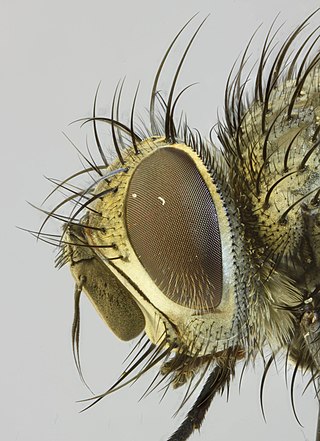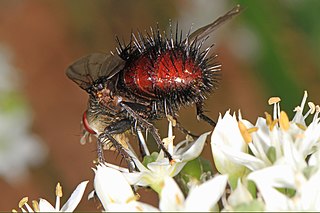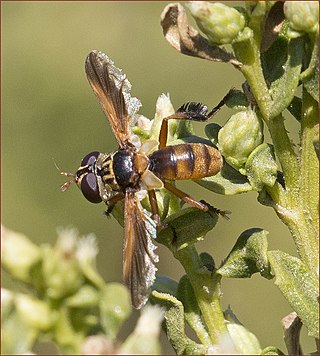
The Tachinidae are a large and variable family of true flies within the insect order Diptera, with more than 8,200 known species and many more to be discovered. Over 1,300 species have been described in North America alone. Insects in this family commonly are called tachinid flies or simply tachinids. As far as is known, they all are protelean parasitoids, or occasionally parasites, of arthropods, usually other insects. The family is known from many habitats in all zoogeographical regions and is especially diverse in South America.

Calyptratae is a subsection of Schizophora in the insect order Diptera, commonly referred to as the calyptrate muscoids. It consists of those flies which possess a calypter that covers the halteres, among which are some of the most familiar of all flies, such as the house fly.
Gymnommopsis cordubensis is a species of fly in the genus Gymnommopsis of the family Tachinidae.
Gymnommopsis gagtea is a species of fly in the genus Gymnommopsis of the family Tachinidae.

Trichopoda pennipes is a species of feather-legged fly in the dipteran family Tachinidae.

Exoristinae is a subfamily of flies in the family Tachinidae. Most species are parasitoids of caterpillars.
Euthera fascipennis is a species of fly in the family Tachinidae. Hosts include Halys dentatus, Apodiphus amygdale, and Dolycoris baccarum.

Tachininae is a subfamily of flies in the family Tachinidae.
Lespesia archippivora is a species of tachinid fly, which, like all tachinids, are parasitoids of other arthropods. L. archippivora lives in the body of its host resulting in its death. This is not uncommon since it is estimated that about 10% of all insects are parasitoids. L. archippivora is a generalist and able to infect at least 25 lepidopteran species in addition to one species of Hymenoptera. It is common in North America and other species exist worldwide. One study suggests the species is bivoltine.
Sturmiopsis inferens is a species of fly in the family Tachinidae. It is native to Asia and is a parasitoid of various moth species whose larvae feed inside the stems of sugarcane, rice and other large grasses, including the Gurdaspur borer and the sugarcane shoot borer.

Phryxe nemea is a species of fly in the family Tachinidae.
Rhachoepalpus olivaceus is a species of bristle fly in the family Tachinidae.
Jurinella lutzi is a species of bristle fly in the family Tachinidae.
Archytas marmoratus, of the marmoratus species group, is a species of bristle fly in the family Tachinidae.

Juriniopsis adusta is a species of bristle fly in the family Tachinidae.
Deopalpus hirsutus is a species of bristle fly in the family Tachinidae.
Archytas analis is a species of bristle fly in the family Tachinidae.

Trichopoda subdivisa, the fringe-legged tachinid fly, is a species of bristle fly in the family Tachinidae.
Rhachoepalpus metallicus is a species of bristle fly in the family Tachinidae.
Oestrophasia uncana is a species of fly in the family Tachinidae.








